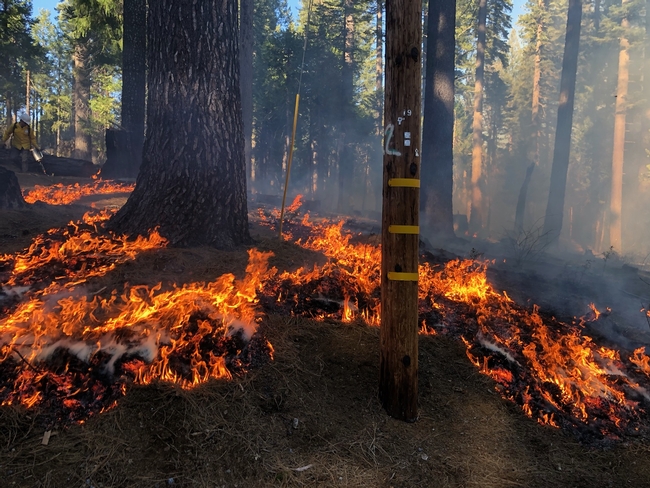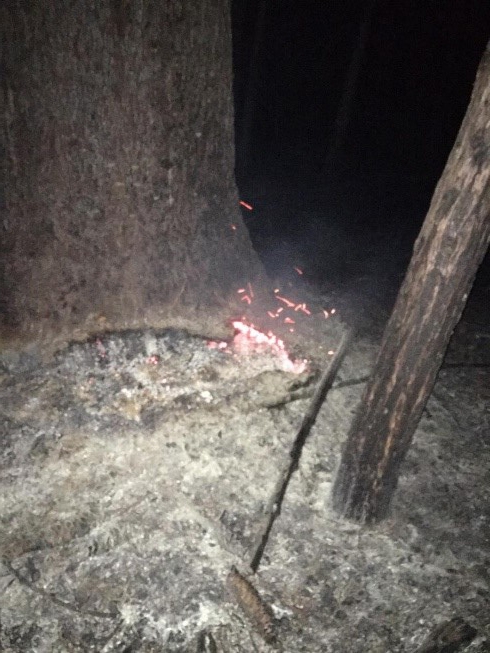Participants from the 2019 prescribed burn workshops put on by the UC ANR Central Sierra were invited to burn at UC Berkeley's Blodgett Forest several times in February. Because January and February were so dry, fuels dried out enough to carry fire.
On Feb. 7, a group of about 20 workshop participants, partners and students burned 15 acres in one day at Blodgett. The burn met objectives of reducing surface fuels and killing young tree seedlings, which inhibited the future development of a ladder fuel layer. Below are some details about the burn to explain how it was carried out.
Burn location: Blodgett staff chose a burn unit for the day based on several factors including forest structure and forecasted winds.
- Forest structure - The unit had been thinned before to open up the canopy allowing fuels to dry out and carry a flame.
- Winds – Strong winds were forecast to occur the day after the burn. Because winds from the north were forecast, a location south of the burn area was chosen to act as an extra wide fuel break. The road also provided good access for mop-up and patrolling along the edge that had the highest probability of slop-over. Additionally, the stand to the south of the burn area had been burned recently and therefore had minimal surface fuel available to burn.
Mop-up: The day following the burn, staff used approximately 50 gallons of water to "mop-up" the north side of our burn before the winds started. Three smoldering stumps within 30 feet of the north line were doused with water, and mixed with a tool until they were out (confirmed by touching the area).
Hot spots: There were three hot spots within the ~15 acre area beyond 30 feet of the north line that were not mopped up, despite the forecast that called for 50 mile an hour winds. There was no need to mop up these hot spots because the fuel around them had been burned.
Patrol: Early Sunday morning, following a night of strong winds, staff patrolled the burn area. Two of the hot spots were still hot, and were casting embers as far as 6 feet away. Because these areas had been burned, there was no chance for the embers to ignite when they landed. Embers traveled, at most, 6 feet away from their source.
Not every fire goes so smoothly, but the mop-up and patrol were smooth and relatively low effort, due to the following factors in this particular case:
- No burn permit was required because the burn occurred outside of fire season and in a mountain county, (a smoke management permit was required, however). This meant that Blodgett staff were able to define an appropriate mop-up and patrol strategy which emphasized fuel consumption.
- Consumption of receptive fuel was high. Because fire was applied systematically across the whole burn area, all of the litter layer receptive to consumption was burned. Embers within the burn area therefore had no receptive fuel to land upon and ignite.
- Overall fuel loading was low because the stand had been burned previously. This made the persistence of heat from the burn short-lived. Unlike with debris piles in which heat can persist for weeks or months, the burn was mostly out within hours after ignition. I expect the rest of the hot spots were out within two days.
Watch short videos filmed at the Feb. 7, 2020 burn:
Ember casting. Not all fuels are extinguished after a prescribed fire. Some larger pieces continue to burn even after all the ignition has been completed. We don't put these out at the end of the day when the point of the fire is to consume fuels. The video shows a stump we lit on fire that continued to burn overnight during a period of high winds. The winds helped embers from the stump disperse, though this was not dangerous because there were very few fuels for them to ignite, because they had been consumed by the fire.
Strip firing. Strip firing means igniting a prescribed fire in strips, in this case with a team walking along with drip torches. Each member of the ignition team lights a strip on fire, walking out and a short distance behind the previous igniter.
For more information, see http://ucanr.edu/rxworkshop

